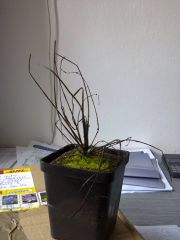-
Posts
44 -
Joined
-
Last visited
Content Type
Profiles
Events
Forums
Gallery
Blogs
Everything posted by Jiri Vanek
-
-

first tuberous drosera flowers this season
Jiri Vanek replied to Dieter's topic in Carnivorous Plants in Cultivation
Hello, perfect pictures of nice plants! Thanks for them. -
Hi guys, Thanks for comments! I was away for a while. D falconeri x ordensis is bigger now and there are typical signs of both parents. Long petioles after D. ordensis and wide laminas after D. falconeri. When you cross two very different plant like these 2 above it's really amazing to watch the final mix :) I will add some actual pictures in some days I hope.
-
Great! Thank you very much guys.
-
Hi guys, this spring I sow some "no-name" seeds I had found in the fridge before. It showed up that it is some byblis but I don't have any idea which one Does anybody identify this plant please ?
-
Yes, I agree. Occasional feeding will be helpful for most CPs. But I think that not many species will react like this. I tried to feed D. filiformis, D. scoriopides, D. capensis and some other ordinary droseras but I haven't noticed any obviously change - positive or negative. But yes - there are some species that require to be fed for good growth. It can be also very useful for tuberous sundews. On the other hand there can be quite serious problems with mould - undigested rests of fodder quickly go mouldly in higher air humidity or when fodder fall to soil. I had to repot my D. indica twice because of an extreme mould on soil (from dropped fodder) which stroke some plants too.
-
H. D. indica seems to me like an exception - I think there are not many species which would react to feeding like this. There could be many other reasons why your seedlings don't grow well and I would guess that feeding is not the right one. But you can try it. I would recomend you to try it just slightly. Some species don't like to be fed much and could react negatively. Good luck!
-
Thanks for comment I used to have "bad luck" with D. indica in past. Seeds always germinated very well but seedlings has never grown up and always has died after 5-6 months. They looked absolutely same like that starving little plants above. Now I know that it wasn't bad luck but they just starved to death. The difference is enormous. To be honest I have to say that it wasn't my idea to feed D. indica so much but advice of my friend and very experienced grower who I get seeds from. This white flower clone of D. indica is very big in general. I guess that until fall when it will propably die it could reach about 60 cm.
-
Yes, he is fed very well
-
Hi! I took some pictures of plants after 4 months from the first photos... Both pots are still at the same place. Both are in absolutely similar condition (temperature, humidity, water) and soil. The biggest plant has about 40 cm from soil to top of the newest leaves now. Note the fast grow of the fed plants (compare pictures from May with these below). Comparision of hungry and fed plants Detail of hungry D. indica:) Fed and happy D. indica :) Happy grower with happy D. indica :)
-
Hi, aphids, definitely.
-
Hi, it's hard to say, the plant doesn't look well. Based on pictures I would exclude D. dilatato-petiolaris. Can be D. petiolaris but...the hairy centre looks like typically D. fulva. On the other hand - the shape and length of leaves point more to D. petiolaris.....for me it seems like it can be a hybrid.
-
Hi, yes, it is classic fish food, nothing special. It is hard to say how often I feed them...simply when I have a feeling that there are to many hungry leaves In general it can be about twice a week. In previous years I had again and again the same problem with D. indica seedlings - in size of about 2-3 mm they stopped growing and after some weeks or a month they died. Now I am quite sure that it was because of the lack of nutrients from prey (=feeding). I'm not sure if it will work with another species. D. indica is quite known for its food demand and good response to feeding. But you can try it :)
-
Hi guys. Let me share with you first results of my experiment with feeding of D. indica. In the beginnenig of this year I decided to sow seeds of D. indica in 2 pots and put them to window sill. As soon as they germinated and produced at least 2 leaves I started to feed seedlings in one pot by chips fodder for fish. Seddlings in the second pot are not fed. In these pictures you can see difference after about 1 month of feeding. Not fed seedlings stopped in about 2mm size and don't grow further. Fed seedlings are after the first month of feeding about 1 cm tall and grow literally before eyes. I don't have to tell you which pot is which I guess :) I will keep in observing the situation and bring more pictures in some weeks.
-
Hi Emiel ! Amazing plants and excelent photos !
-
Hi, D. prolifera likes very high air humidity, stable temperatures about 20-25°C and not much light (doesn't like direct sun). Soil can be mixture of peat and sand. Sow the seeds in the same conditions. From my own experineces seedlings of D. prolifera grow pretty slowly in comparision with plants from leaf cuttings. So take patience :)







